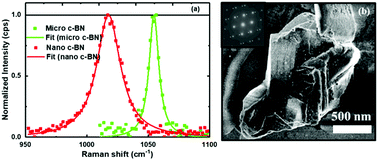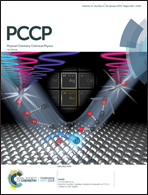Formation and characterization of nano- and microstructures of twinned cubic boron nitride
Abstract
Nano- and microstructures of phase-pure cubic boron nitride (c-BN) are synthesized by employing nanosecond pulsed-laser annealing techniques at room temperature and atmospheric pressure. In a highly non-equilibrium synthesis process, nanocrystalline h-BN is directly converted into phase-pure twinned c-BN from a highly undercooled melt state of BN. By changing nucleation and growth rates, we have synthesized a wide range of sizes (90 nm to 25 μm) of c-BN. The electron diffraction patterns show the formation of twinned c-BN with [1![[1 with combining macron]](https://www.rsc.org/images/entities/char_0031_0304.gif) 1] as the twin axis. The twinning density in c-BN can be controlled by the degree of undercooling and quenching rates. The formation of twins predominantly occurs prior to the formation of amorphous quenched BN (Q-BN). Therefore, the defect density in nano c-BN formed under higher undercooling conditions is considerably larger than that in micro c-BN, which is formed under lower undercooling conditions. The temperature-dependent Raman studies show a considerable blue-shift of ∼6 cm−1 with a decrease in temperature from 300 to 78 K in nano c-BN as compared to micro c-BN. The size-effects of c-BN crystals in Raman spectra are modeled using spatial correlation theory, which can be used to calculate the correlation length and twin density in c-BN. It has also been found that the Raman blue-shift in nano c-BN is caused by anharmonic effects, and the decrease in Raman linewidth with decreasing temperature (300 to 78 K) is caused by three- and four-phonon decay processes. The bonding characteristics and crystalline nature of the synthesized c-BN are also demonstrated by using electron energy-loss spectroscopy and electron backscatter diffraction, respectively. We envisage that the controlled growth of phase-pure nano and microstructures of twinned c-BN and their temperature-dependent Raman-active vibrational mode studies will have a tremendous impact on low-temperature solid-state electrical and mechanical devices.
1] as the twin axis. The twinning density in c-BN can be controlled by the degree of undercooling and quenching rates. The formation of twins predominantly occurs prior to the formation of amorphous quenched BN (Q-BN). Therefore, the defect density in nano c-BN formed under higher undercooling conditions is considerably larger than that in micro c-BN, which is formed under lower undercooling conditions. The temperature-dependent Raman studies show a considerable blue-shift of ∼6 cm−1 with a decrease in temperature from 300 to 78 K in nano c-BN as compared to micro c-BN. The size-effects of c-BN crystals in Raman spectra are modeled using spatial correlation theory, which can be used to calculate the correlation length and twin density in c-BN. It has also been found that the Raman blue-shift in nano c-BN is caused by anharmonic effects, and the decrease in Raman linewidth with decreasing temperature (300 to 78 K) is caused by three- and four-phonon decay processes. The bonding characteristics and crystalline nature of the synthesized c-BN are also demonstrated by using electron energy-loss spectroscopy and electron backscatter diffraction, respectively. We envisage that the controlled growth of phase-pure nano and microstructures of twinned c-BN and their temperature-dependent Raman-active vibrational mode studies will have a tremendous impact on low-temperature solid-state electrical and mechanical devices.

- This article is part of the themed collection: 2018 PCCP HOT Articles


 Please wait while we load your content...
Please wait while we load your content...
